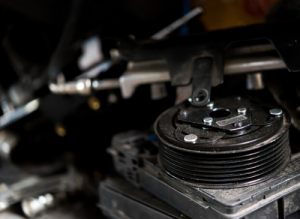© 2023 Auto/Mate, Inc. All Rights Reserved.
By Ken Rock, Customer Care Manager
Does your dealership have a process for tracking dirty cores? If you don’t, or even if you do but your employees aren’t following that process, you could be losing out on a lot of money.
For the non-parts people out there, a dirty core is a used part that can be refurbished and used again. When a factory sells a dealership certain parts, they add a core charge, which the dealership then passes onto their customers.

When a car is serviced and the dealership puts in a new part with a core, the old part that comes out is referred to as a ‘dirty core’ because it’s well, dirty. Literally—black, oily and nasty.
The core charge exists because the manufacturers want to refurbish the old parts. To encourage dealerships to send the old parts back, the OEM reimburses the original core charge when a dirty part is returned. All that’s required is for the dealership to fill out a claims form and ship the part back to the factory.
The problem occurs when the parts employees get busy or just don’t care enough to send back the parts, because they don’t view the dirty cores as real money. Instead, the parts just get piled up somewhere in the back of the parts department. When I visit dealerships I frequently see anywhere from $500 to $5,000 worth of dirty cores lying around.
Perhaps you’re not worried because eventually they’ll all be returned and you get your money, right? Well, maybe, maybe not. If you don’t have a process to track them, what’s to stop some of your dirty parts from disappearing? After all, they’re just old, dirty parts that nobody wants, right? That’s the justification.
Many dealers don’t have a process in place to track their dirty cores, and that’s a mistake that costs them money.
However, if you have an efficient parts manager they know exactly how many cores you have, they process the returns on a weekly basis and they know exactly how much money was received for those cores. Unfortunately, in my experience, this is not the norm.
In most dealerships this process is rarely documented and poorly monitored. One of the first things I do when I visit parts departments is to find the stash of dirty cores and get the managers involved to assign a value to them.
Sometimes I’ve seen where the parts department do return the parts and get credited for the cores. But the accounting department has no idea where to post these credits because they’re not tied to anything, so sometimes they’re posted to the wrong category. One option to fix this is to use a process where the dirty cores get tracked on a parts invoice, so when they’re paid the accounting office knows what to do.
Your DMS should also have a way to track your dirty cores. Whenever a new part with a core charge is sold, the DMS should automatically calculate and add the correct core charge amount to the customer’s invoice. When a dirty core is returned, you add that part back to your inventory so that it can be easily tracked in a report. Once a week the parts manager runs the “dirty cores” report which lists all the parts to send back for reimbursement. Now you have a process.
When your dirty core charges are paid by the OEM, the credits are posted directly to parts inventory so it’s clear to accounting how to post the credits.
More than likely your dealership already has this functionality in your DMS, and the process is very easy to do once it’s set up. All it needs is one person to monitor and hold someone else accountable, to make sure they do what they’re supposed to be doing. In most dealerships, this isn’t being done. Why not?
Dealers I challenge you to go and take a look at your parts department, and see how many dirty cores you have lying around. How much money are you missing out on? You’ll never know until a process is established and employees are held accountable for following it.